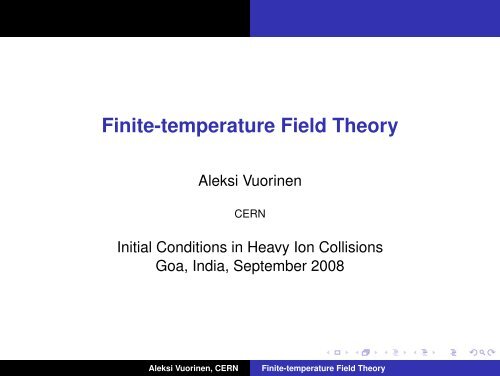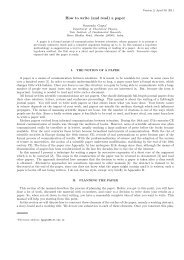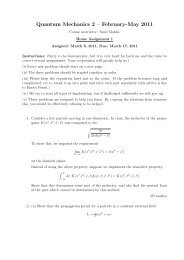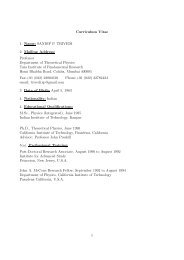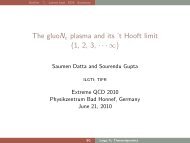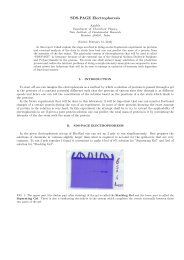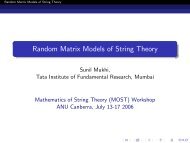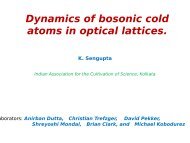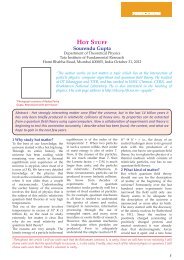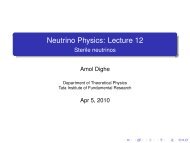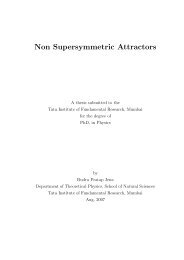Finite-temperature Field Theory - Theoretical Physics (TIFR)
Finite-temperature Field Theory - Theoretical Physics (TIFR)
Finite-temperature Field Theory - Theoretical Physics (TIFR)
You also want an ePaper? Increase the reach of your titles
YUMPU automatically turns print PDFs into web optimized ePapers that Google loves.
<strong>Finite</strong>-<strong>temperature</strong> <strong>Field</strong> <strong>Theory</strong><br />
Aleksi Vuorinen<br />
CERN<br />
Initial Conditions in Heavy Ion Collisions<br />
Goa, India, September 2008<br />
logo<br />
Aleksi Vuorinen, CERN<br />
<strong>Finite</strong>-<strong>temperature</strong> <strong>Field</strong> <strong>Theory</strong>
Basics of Statistical <strong>Physics</strong> and Thermodynamics<br />
Scalar fields at finite <strong>temperature</strong><br />
Interacting scalar fields<br />
Why is finite T /µ physics (≈ QCD) interesting?<br />
High energy physics applications<br />
◮ Heavy ion experiments ⇒ Need<br />
quantitive understanding of<br />
non-Abelian plasmas at<br />
◮ High T and small/moderate µ<br />
◮ Moderately large couplings<br />
◮ In and (especially) out of<br />
equilibrium<br />
◮ Early universe thermodynamics<br />
◮ Signatures of phase transitions<br />
◮ EW baryogenesis<br />
◮ Cosmic relics<br />
◮ Neutron star cores<br />
logo<br />
Aleksi Vuorinen, CERN<br />
<strong>Finite</strong>-<strong>temperature</strong> <strong>Field</strong> <strong>Theory</strong>
Basics of Statistical <strong>Physics</strong> and Thermodynamics<br />
Scalar fields at finite <strong>temperature</strong><br />
Interacting scalar fields<br />
In these lectures we will, however, only cover the very basics of<br />
finite-T formalism, restricting ourselves to<br />
◮ Equilibrium physics — imaginary-time formalism<br />
◮ Purely perturbative tools<br />
For other approaches/setups, see in particular Guy Moore’s<br />
lectures...<br />
logo<br />
Aleksi Vuorinen, CERN<br />
<strong>Finite</strong>-<strong>temperature</strong> <strong>Field</strong> <strong>Theory</strong>
Basics of Statistical <strong>Physics</strong> and Thermodynamics<br />
Scalar fields at finite <strong>temperature</strong><br />
Interacting scalar fields<br />
Plan of the lectures<br />
◮ Lecture 1: Basic tools in finite-<strong>temperature</strong> field theory<br />
◮ Reminder of statistical physics<br />
◮ Scalar field theories and equilibrium thermodynamics<br />
◮ Interacting scalar fields at T ≠ 0: λϕ 4 theory<br />
◮ Lecture 2: Gauge field theories and linear response<br />
◮ More tools for finite-<strong>temperature</strong> calculations<br />
◮ Gauge symmetry, QED and QCD<br />
◮ Linear response theory<br />
◮ Lecture 3: Special applications in QCD<br />
◮ Phases of hot and dense QCD<br />
◮ The IR problem<br />
◮ Dimensional reduction and high-T effective theories<br />
logo<br />
Aleksi Vuorinen, CERN<br />
<strong>Finite</strong>-<strong>temperature</strong> <strong>Field</strong> <strong>Theory</strong>
Basics of Statistical <strong>Physics</strong> and Thermodynamics<br />
Scalar fields at finite <strong>temperature</strong><br />
Interacting scalar fields<br />
Some useful reading<br />
Material used in preparing these lectures:<br />
◮ J. Kapusta, <strong>Finite</strong>-<strong>temperature</strong> field theory<br />
◮ M. Le Bellac, Thermal field theory<br />
◮ A. Rebhan, Thermal gauge field theories, hep-ph/0105183<br />
◮ D. Rischke, Quark-gluon plasma in equilibrium,<br />
nucl-th/0305030<br />
◮ ...<br />
logo<br />
Aleksi Vuorinen, CERN<br />
<strong>Finite</strong>-<strong>temperature</strong> <strong>Field</strong> <strong>Theory</strong>
Basics of Statistical <strong>Physics</strong> and Thermodynamics<br />
Scalar fields at finite <strong>temperature</strong><br />
Interacting scalar fields<br />
Outline<br />
Basics of Statistical <strong>Physics</strong> and Thermodynamics<br />
Statistical QM<br />
Simple examples<br />
Scalar fields at finite <strong>temperature</strong><br />
Partition function for scalar field theory<br />
Non-interacting examples<br />
Interacting scalar fields<br />
Feynman rules at finite <strong>temperature</strong><br />
Thermodynamics of ϕ 4 theory<br />
logo<br />
Aleksi Vuorinen, CERN<br />
<strong>Finite</strong>-<strong>temperature</strong> <strong>Field</strong> <strong>Theory</strong>
Basics of Statistical <strong>Physics</strong> and Thermodynamics<br />
Scalar fields at finite <strong>temperature</strong><br />
Interacting scalar fields<br />
Statistical QM<br />
Simple examples<br />
Outline<br />
Basics of Statistical <strong>Physics</strong> and Thermodynamics<br />
Statistical QM<br />
Simple examples<br />
Scalar fields at finite <strong>temperature</strong><br />
Partition function for scalar field theory<br />
Non-interacting examples<br />
Interacting scalar fields<br />
Feynman rules at finite <strong>temperature</strong><br />
Thermodynamics of ϕ 4 theory<br />
logo<br />
Aleksi Vuorinen, CERN<br />
<strong>Finite</strong>-<strong>temperature</strong> <strong>Field</strong> <strong>Theory</strong>
Basics of Statistical <strong>Physics</strong> and Thermodynamics<br />
Scalar fields at finite <strong>temperature</strong><br />
Interacting scalar fields<br />
Statistical QM<br />
Simple examples<br />
Grand canonical ensemble<br />
◮ Assume system that is free to exchange both energy and<br />
particles with a reservoir<br />
◮ ”Grand canonical ensemble”<br />
◮ System described by <strong>temperature</strong> T and chemical<br />
potentials µ i<br />
◮ Basic operator statistical density matrix ˆρ<br />
[<br />
]<br />
ˆρ ≡ Z −1 exp −β(Ĥ − µ ˆN i<br />
} {{ } i ) ,<br />
≡ ¯H<br />
〈Â〉 = Tr[ˆρÂ]<br />
◮<br />
β = 1/T and µ Lagrangian multipliers ensuring<br />
conservation of E and N i<br />
logo<br />
Aleksi Vuorinen, CERN<br />
<strong>Finite</strong>-<strong>temperature</strong> <strong>Field</strong> <strong>Theory</strong>
Basics of Statistical <strong>Physics</strong> and Thermodynamics<br />
Scalar fields at finite <strong>temperature</strong><br />
Interacting scalar fields<br />
Statistical QM<br />
Simple examples<br />
Grand canonical ensemble<br />
◮ Assume system that is free to exchange both energy and<br />
particles with a reservoir<br />
◮ ”Grand canonical ensemble”<br />
◮ System described by <strong>temperature</strong> T and chemical<br />
potentials µ i<br />
◮ Basic operator statistical density matrix ˆρ<br />
[<br />
]<br />
ˆρ ≡ Z −1 exp −β(Ĥ − µ ˆN i<br />
} {{ } i ) ,<br />
≡ ¯H<br />
〈Â〉 = Tr[ˆρÂ]<br />
◮<br />
β = 1/T and µ Lagrangian multipliers ensuring<br />
conservation of E and N i<br />
logo<br />
Aleksi Vuorinen, CERN<br />
<strong>Finite</strong>-<strong>temperature</strong> <strong>Field</strong> <strong>Theory</strong>
Basics of Statistical <strong>Physics</strong> and Thermodynamics<br />
Scalar fields at finite <strong>temperature</strong><br />
Interacting scalar fields<br />
Statistical QM<br />
Simple examples<br />
◮ Most important quantity in equilibrium thermodynamics:<br />
The partition function Z<br />
Z (V , T , µ i ) = Tr e −β ¯H = ∑ i<br />
〈i|e −β ¯H|i〉 = ∑ e −βE i<br />
◮ Several thermodynamic quantities available through<br />
derivatives of Z (due to above relation for expectation<br />
values)<br />
p = −Ω/V = 1<br />
βV ln Z ,<br />
N i = 1 V 〈 ˆN i 〉 = ∂P<br />
∂µ i<br />
ε = 1 V 〈Ĥ〉 = − 1 V<br />
∂ln Z<br />
∂β<br />
logo<br />
Aleksi Vuorinen, CERN<br />
<strong>Finite</strong>-<strong>temperature</strong> <strong>Field</strong> <strong>Theory</strong>
Basics of Statistical <strong>Physics</strong> and Thermodynamics<br />
Scalar fields at finite <strong>temperature</strong><br />
Interacting scalar fields<br />
Statistical QM<br />
Simple examples<br />
◮ Most important quantity in equilibrium thermodynamics:<br />
The partition function Z<br />
Z (V , T , µ i ) = Tr e −β ¯H = ∑ i<br />
〈i|e −β ¯H|i〉 = ∑ e −βE i<br />
◮ Several thermodynamic quantities available through<br />
derivatives of Z (due to above relation for expectation<br />
values)<br />
p = −Ω/V = 1<br />
βV ln Z ,<br />
N i = 1 V 〈 ˆN i 〉 = ∂P<br />
∂µ i<br />
ε = 1 V 〈Ĥ〉 = − 1 V<br />
∂ln Z<br />
∂β<br />
logo<br />
Aleksi Vuorinen, CERN<br />
<strong>Finite</strong>-<strong>temperature</strong> <strong>Field</strong> <strong>Theory</strong>
Basics of Statistical <strong>Physics</strong> and Thermodynamics<br />
Scalar fields at finite <strong>temperature</strong><br />
Interacting scalar fields<br />
Statistical QM<br />
Simple examples<br />
s = S/V = 1 V 〈−lnˆρ〉 = 1 V ln Z + β V 〈Ĥ − µ i ˆN i 〉<br />
= ∂P<br />
∂T = β(P + ε − µ iN i )<br />
◮ Finally obtain energy through other quantities as<br />
E = −PV + TS + µ i N i<br />
◮ Important to note: Thermodynamic pressure =<br />
hydrodynamics pressure = 1 3 〈T ii 〉<br />
logo<br />
Aleksi Vuorinen, CERN<br />
<strong>Finite</strong>-<strong>temperature</strong> <strong>Field</strong> <strong>Theory</strong>
Basics of Statistical <strong>Physics</strong> and Thermodynamics<br />
Scalar fields at finite <strong>temperature</strong><br />
Interacting scalar fields<br />
Statistical QM<br />
Simple examples<br />
s = S/V = 1 V 〈−lnˆρ〉 = 1 V ln Z + β V 〈Ĥ − µ i ˆN i 〉<br />
= ∂P<br />
∂T = β(P + ε − µ iN i )<br />
◮ Finally obtain energy through other quantities as<br />
E = −PV + TS + µ i N i<br />
◮ Important to note: Thermodynamic pressure =<br />
hydrodynamics pressure = 1 3 〈T ii 〉<br />
logo<br />
Aleksi Vuorinen, CERN<br />
<strong>Finite</strong>-<strong>temperature</strong> <strong>Field</strong> <strong>Theory</strong>
Basics of Statistical <strong>Physics</strong> and Thermodynamics<br />
Scalar fields at finite <strong>temperature</strong><br />
Interacting scalar fields<br />
Statistical QM<br />
Simple examples<br />
s = S/V = 1 V 〈−lnˆρ〉 = 1 V ln Z + β V 〈Ĥ − µ i ˆN i 〉<br />
= ∂P<br />
∂T = β(P + ε − µ iN i )<br />
◮ Finally obtain energy through other quantities as<br />
E = −PV + TS + µ i N i<br />
◮ Important to note: Thermodynamic pressure =<br />
hydrodynamics pressure = 1 3 〈T ii 〉<br />
logo<br />
Aleksi Vuorinen, CERN<br />
<strong>Finite</strong>-<strong>temperature</strong> <strong>Field</strong> <strong>Theory</strong>
Basics of Statistical <strong>Physics</strong> and Thermodynamics<br />
Scalar fields at finite <strong>temperature</strong><br />
Interacting scalar fields<br />
Statistical QM<br />
Simple examples<br />
QM harmonic oscillator<br />
Use energy basis to obtain (in canonical ensemble):<br />
logo<br />
Aleksi Vuorinen, CERN<br />
<strong>Finite</strong>-<strong>temperature</strong> <strong>Field</strong> <strong>Theory</strong>
Basics of Statistical <strong>Physics</strong> and Thermodynamics<br />
Scalar fields at finite <strong>temperature</strong><br />
Interacting scalar fields<br />
Statistical QM<br />
Simple examples<br />
One degree of freedom<br />
◮ Consider one state system with E = ω, and ignore zero<br />
point energy<br />
Ĥ | n〉 = ω ˆN | n〉 = n ω | n〉<br />
◮ For bosons/fermions with chemical potential µ, obtain<br />
∞∑<br />
Z b = Tr e −β(ω−µ) ˆN = 〈n | e −β(ω−µ) ˆN 1<br />
| n〉 =<br />
1 − e ,<br />
−β(ω−µ)<br />
Z f = Tr e −β(ω−µ) ˆN =<br />
n=1<br />
1∑<br />
〈n | e −β(ω−µ) ˆN | n〉 = 1 + e −β(ω−µ)<br />
n=1<br />
◮ Taking derivatives...<br />
N b =<br />
1<br />
e β(ω−µ) − 1 , E b = ωN b<br />
N f =<br />
1<br />
e β(ω−µ) + 1 , E f = ωN f<br />
logo<br />
Aleksi Vuorinen, CERN<br />
<strong>Finite</strong>-<strong>temperature</strong> <strong>Field</strong> <strong>Theory</strong>
Basics of Statistical <strong>Physics</strong> and Thermodynamics<br />
Scalar fields at finite <strong>temperature</strong><br />
Interacting scalar fields<br />
Statistical QM<br />
Simple examples<br />
One degree of freedom<br />
◮ Consider one state system with E = ω, and ignore zero<br />
point energy<br />
Ĥ | n〉 = ω ˆN | n〉 = n ω | n〉<br />
◮ For bosons/fermions with chemical potential µ, obtain<br />
∞∑<br />
Z b = Tr e −β(ω−µ) ˆN = 〈n | e −β(ω−µ) ˆN 1<br />
| n〉 =<br />
1 − e ,<br />
−β(ω−µ)<br />
Z f = Tr e −β(ω−µ) ˆN =<br />
n=1<br />
1∑<br />
〈n | e −β(ω−µ) ˆN | n〉 = 1 + e −β(ω−µ)<br />
n=1<br />
◮ Taking derivatives...<br />
N b =<br />
1<br />
e β(ω−µ) − 1 , E b = ωN b<br />
N f =<br />
1<br />
e β(ω−µ) + 1 , E f = ωN f<br />
logo<br />
Aleksi Vuorinen, CERN<br />
<strong>Finite</strong>-<strong>temperature</strong> <strong>Field</strong> <strong>Theory</strong>
Basics of Statistical <strong>Physics</strong> and Thermodynamics<br />
Scalar fields at finite <strong>temperature</strong><br />
Interacting scalar fields<br />
Statistical QM<br />
Simple examples<br />
One degree of freedom<br />
◮ Consider one state system with E = ω, and ignore zero<br />
point energy<br />
Ĥ | n〉 = ω ˆN | n〉 = n ω | n〉<br />
◮ For bosons/fermions with chemical potential µ, obtain<br />
∞∑<br />
Z b = Tr e −β(ω−µ) ˆN = 〈n | e −β(ω−µ) ˆN 1<br />
| n〉 =<br />
1 − e ,<br />
−β(ω−µ)<br />
Z f = Tr e −β(ω−µ) ˆN =<br />
n=1<br />
1∑<br />
〈n | e −β(ω−µ) ˆN | n〉 = 1 + e −β(ω−µ)<br />
n=1<br />
◮ Taking derivatives...<br />
N b =<br />
1<br />
e β(ω−µ) − 1 , E b = ωN b<br />
N f =<br />
1<br />
e β(ω−µ) + 1 , E f = ωN f<br />
logo<br />
Aleksi Vuorinen, CERN<br />
<strong>Finite</strong>-<strong>temperature</strong> <strong>Field</strong> <strong>Theory</strong>
Basics of Statistical <strong>Physics</strong> and Thermodynamics<br />
Scalar fields at finite <strong>temperature</strong><br />
Interacting scalar fields<br />
Partition function for scalar field theory<br />
Non-interacting examples<br />
Outline<br />
Basics of Statistical <strong>Physics</strong> and Thermodynamics<br />
Statistical QM<br />
Simple examples<br />
Scalar fields at finite <strong>temperature</strong><br />
Partition function for scalar field theory<br />
Non-interacting examples<br />
Interacting scalar fields<br />
Feynman rules at finite <strong>temperature</strong><br />
Thermodynamics of ϕ 4 theory<br />
logo<br />
Aleksi Vuorinen, CERN<br />
<strong>Finite</strong>-<strong>temperature</strong> <strong>Field</strong> <strong>Theory</strong>
Basics of Statistical <strong>Physics</strong> and Thermodynamics<br />
Scalar fields at finite <strong>temperature</strong><br />
Interacting scalar fields<br />
Partition function for scalar field theory<br />
Non-interacting examples<br />
Partition function<br />
◮ Consider real scalar field theory with no chemical<br />
potentials<br />
∫ ∫<br />
S = dt d 3 xL,<br />
L = 1 2<br />
{<br />
(∂ t φ) 2 − (∂ i φ) 2 } − V (φ)<br />
◮ To obtain equilibrium thermodynamics, want to compute<br />
partition function<br />
∫<br />
Z = Dφ〈φ | e −βĤ | φ〉<br />
logo<br />
Aleksi Vuorinen, CERN<br />
<strong>Finite</strong>-<strong>temperature</strong> <strong>Field</strong> <strong>Theory</strong>
Basics of Statistical <strong>Physics</strong> and Thermodynamics<br />
Scalar fields at finite <strong>temperature</strong><br />
Interacting scalar fields<br />
Partition function for scalar field theory<br />
Non-interacting examples<br />
Partition function<br />
◮ Consider real scalar field theory with no chemical<br />
potentials<br />
∫ ∫<br />
S = dt d 3 xL,<br />
L = 1 2<br />
{<br />
(∂ t φ) 2 − (∂ i φ) 2 } − V (φ)<br />
◮ To obtain equilibrium thermodynamics, want to compute<br />
partition function<br />
∫<br />
Z = Dφ〈φ | e −βĤ | φ〉<br />
logo<br />
Aleksi Vuorinen, CERN<br />
<strong>Finite</strong>-<strong>temperature</strong> <strong>Field</strong> <strong>Theory</strong>
Basics of Statistical <strong>Physics</strong> and Thermodynamics<br />
Scalar fields at finite <strong>temperature</strong><br />
Interacting scalar fields<br />
Partition function for scalar field theory<br />
Non-interacting examples<br />
◮ Recall path integral for transition amplitudes in QFT:<br />
〈φ b (x) | e −iĤ(t 1−t 0 ) | φ a (x)〉<br />
∫ [ ∫ t1<br />
∫ ]<br />
= N Dϕ exp i dt d 3 x L<br />
t 0<br />
ϕ(t 0 ,x)=φa(x)<br />
ϕ(t 1 ,x)=φ b (x)<br />
◮ For thermodynamic purposes, set t 0 = t 1 , t → −iτ:<br />
∫ β−it0 ∫<br />
iS → − dτ d d xL E ,<br />
L E = 1 2<br />
−it 0<br />
{<br />
(∂ t ϕ) 2 + (∂ i ϕ) 2 } + V (ϕ)<br />
◮ Finally, taking the trace...<br />
∫<br />
[<br />
Z = N Dϕ exp<br />
periodic<br />
∫ β−it0 ∫<br />
− dτ<br />
−it 0<br />
d d xL E<br />
]<br />
logo<br />
Aleksi Vuorinen, CERN<br />
<strong>Finite</strong>-<strong>temperature</strong> <strong>Field</strong> <strong>Theory</strong>
Basics of Statistical <strong>Physics</strong> and Thermodynamics<br />
Scalar fields at finite <strong>temperature</strong><br />
Interacting scalar fields<br />
Partition function for scalar field theory<br />
Non-interacting examples<br />
◮ Recall path integral for transition amplitudes in QFT:<br />
〈φ b (x) | e −iĤ(t 1−t 0 ) | φ a (x)〉<br />
∫ [ ∫ t1<br />
∫ ]<br />
= N Dϕ exp i dt d 3 x L<br />
t 0<br />
ϕ(t 0 ,x)=φa(x)<br />
ϕ(t 1 ,x)=φ b (x)<br />
◮ For thermodynamic purposes, set t 0 = t 1 , t → −iτ:<br />
∫ β−it0 ∫<br />
iS → − dτ d d xL E ,<br />
L E = 1 2<br />
−it 0<br />
{<br />
(∂ t ϕ) 2 + (∂ i ϕ) 2 } + V (ϕ)<br />
◮ Finally, taking the trace...<br />
∫<br />
[<br />
Z = N Dϕ exp<br />
periodic<br />
∫ β−it0 ∫<br />
− dτ<br />
−it 0<br />
d d xL E<br />
]<br />
logo<br />
Aleksi Vuorinen, CERN<br />
<strong>Finite</strong>-<strong>temperature</strong> <strong>Field</strong> <strong>Theory</strong>
Basics of Statistical <strong>Physics</strong> and Thermodynamics<br />
Scalar fields at finite <strong>temperature</strong><br />
Interacting scalar fields<br />
Partition function for scalar field theory<br />
Non-interacting examples<br />
◮ Recall path integral for transition amplitudes in QFT:<br />
〈φ b (x) | e −iĤ(t 1−t 0 ) | φ a (x)〉<br />
∫ [ ∫ t1<br />
∫ ]<br />
= N Dϕ exp i dt d 3 x L<br />
t 0<br />
ϕ(t 0 ,x)=φa(x)<br />
ϕ(t 1 ,x)=φ b (x)<br />
◮ For thermodynamic purposes, set t 0 = t 1 , t → −iτ:<br />
∫ β−it0 ∫<br />
iS → − dτ d d xL E ,<br />
L E = 1 2<br />
−it 0<br />
{<br />
(∂ t ϕ) 2 + (∂ i ϕ) 2 } + V (ϕ)<br />
◮ Finally, taking the trace...<br />
∫<br />
[<br />
Z = N Dϕ exp<br />
periodic<br />
∫ β−it0 ∫<br />
− dτ<br />
−it 0<br />
d d xL E<br />
]<br />
logo<br />
Aleksi Vuorinen, CERN<br />
<strong>Finite</strong>-<strong>temperature</strong> <strong>Field</strong> <strong>Theory</strong>
Basics of Statistical <strong>Physics</strong> and Thermodynamics<br />
Scalar fields at finite <strong>temperature</strong><br />
Interacting scalar fields<br />
Partition function for scalar field theory<br />
Non-interacting examples<br />
A few things to note:<br />
◮ Periodicity of fields: Integrate over all ϕ satisfying<br />
ϕ(−it 0 , x) = ϕ(β − it 0 , x)<br />
◮ Simple consequence of taking the trace<br />
◮ Compactness of time direction<br />
◮ For equilibrium thermodynamics, may set t 0 = 0<br />
◮ Real Gaussian path integral<br />
◮ No issues of existence/convergence<br />
◮ Inclusion of finite chemical potentials straightforward<br />
(coming up in detail...)<br />
logo<br />
Aleksi Vuorinen, CERN<br />
<strong>Finite</strong>-<strong>temperature</strong> <strong>Field</strong> <strong>Theory</strong>
Basics of Statistical <strong>Physics</strong> and Thermodynamics<br />
Scalar fields at finite <strong>temperature</strong><br />
Interacting scalar fields<br />
Partition function for scalar field theory<br />
Non-interacting examples<br />
Side remark: Direct proof of periodicity<br />
◮ Define thermal (time-ordered) Green’s function<br />
[<br />
G B (x, y; τ, 0) = Tr<br />
{ˆρT τ ˆφ(x, τ) ˆφ(y, 0) ]}<br />
◮ Using cyclic property of the trace...<br />
{<br />
G B (x, y; τ, 0) = Z −1 Tr e −βĤe }<br />
βĤ ˆφ(y, 0)e −βĤ ˆφ(x, τ)<br />
{<br />
}<br />
= Z −1 Tr e −βĤ ˆφ(y, β) ˆφ(x, τ)<br />
= Z −1 Tr<br />
{e −βĤT [ ]<br />
τ ˆφ(x, τ) ˆφ(y, }<br />
β)<br />
= G B (x, y; τ, β)<br />
logo<br />
Aleksi Vuorinen, CERN<br />
<strong>Finite</strong>-<strong>temperature</strong> <strong>Field</strong> <strong>Theory</strong>
Basics of Statistical <strong>Physics</strong> and Thermodynamics<br />
Scalar fields at finite <strong>temperature</strong><br />
Interacting scalar fields<br />
Partition function for scalar field theory<br />
Non-interacting examples<br />
Massive scalar fields<br />
◮ Specialize now to V (ϕ) = 1 2 m2 ϕ 2<br />
◮<br />
One free bosonic dof<br />
◮ Following rules of Gaussian integration<br />
{<br />
}<br />
(<br />
) −1/2<br />
ln Z = ln N det (−∂τ 2 − ∂i 2 + m 2 )<br />
= − 1 2 Tr ln (−∂2 τ − ∂i 2 + m 2 ) + const.<br />
◮ How to take a trace of an operator containing derivatives?<br />
◮<br />
Go to momentum space!<br />
logo<br />
Aleksi Vuorinen, CERN<br />
<strong>Finite</strong>-<strong>temperature</strong> <strong>Field</strong> <strong>Theory</strong>
Basics of Statistical <strong>Physics</strong> and Thermodynamics<br />
Scalar fields at finite <strong>temperature</strong><br />
Interacting scalar fields<br />
Partition function for scalar field theory<br />
Non-interacting examples<br />
Massive scalar fields<br />
◮ Specialize now to V (ϕ) = 1 2 m2 ϕ 2<br />
◮<br />
One free bosonic dof<br />
◮ Following rules of Gaussian integration<br />
{<br />
}<br />
(<br />
) −1/2<br />
ln Z = ln N det (−∂τ 2 − ∂i 2 + m 2 )<br />
= − 1 2 Tr ln (−∂2 τ − ∂i 2 + m 2 ) + const.<br />
◮ How to take a trace of an operator containing derivatives?<br />
◮<br />
Go to momentum space!<br />
logo<br />
Aleksi Vuorinen, CERN<br />
<strong>Finite</strong>-<strong>temperature</strong> <strong>Field</strong> <strong>Theory</strong>
Basics of Statistical <strong>Physics</strong> and Thermodynamics<br />
Scalar fields at finite <strong>temperature</strong><br />
Interacting scalar fields<br />
Partition function for scalar field theory<br />
Non-interacting examples<br />
Massive scalar fields<br />
◮ Specialize now to V (ϕ) = 1 2 m2 ϕ 2<br />
◮<br />
One free bosonic dof<br />
◮ Following rules of Gaussian integration<br />
{<br />
}<br />
(<br />
) −1/2<br />
ln Z = ln N det (−∂τ 2 − ∂i 2 + m 2 )<br />
= − 1 2 Tr ln (−∂2 τ − ∂i 2 + m 2 ) + const.<br />
◮ How to take a trace of an operator containing derivatives?<br />
◮<br />
Go to momentum space!<br />
logo<br />
Aleksi Vuorinen, CERN<br />
<strong>Finite</strong>-<strong>temperature</strong> <strong>Field</strong> <strong>Theory</strong>
Basics of Statistical <strong>Physics</strong> and Thermodynamics<br />
Scalar fields at finite <strong>temperature</strong><br />
Interacting scalar fields<br />
Partition function for scalar field theory<br />
Non-interacting examples<br />
Massive scalar fields<br />
◮ Specialize now to V (ϕ) = 1 2 m2 ϕ 2<br />
◮<br />
One free bosonic dof<br />
◮ Following rules of Gaussian integration<br />
{<br />
}<br />
(<br />
) −1/2<br />
ln Z = ln N det (−∂τ 2 − ∂i 2 + m 2 )<br />
= − 1 2 Tr ln (−∂2 τ − ∂i 2 + m 2 ) + const.<br />
◮ How to take a trace of an operator containing derivatives?<br />
◮<br />
Go to momentum space!<br />
logo<br />
Aleksi Vuorinen, CERN<br />
<strong>Finite</strong>-<strong>temperature</strong> <strong>Field</strong> <strong>Theory</strong>
Basics of Statistical <strong>Physics</strong> and Thermodynamics<br />
Scalar fields at finite <strong>temperature</strong><br />
Interacting scalar fields<br />
Partition function for scalar field theory<br />
Non-interacting examples<br />
◮ Expand fields in terms of their Fourier modes<br />
◮<br />
ϕ(τ, x) = T ∑ ∫<br />
d 3 p<br />
ei(p·x+ωnτ)<br />
(2π) 3 ϕ n (p),<br />
n<br />
ω n = 2nπT , n ∈ Z<br />
Fourier series in τ direction due to compactness of<br />
temporal direction<br />
◮ Now, a short exercise produces (up to T -indep. constant)<br />
ln Z = − V ∑<br />
∫<br />
d 3 (<br />
p<br />
2 (2π) 3 ln n 2 + β2 (p 2 + m 2 )<br />
)<br />
(2π) 2 n<br />
∫ [√<br />
d 3 p p<br />
= −V<br />
2 + m 2<br />
(2π) 3 + ln<br />
(1 − e −β√ p 2 +m 2) ]<br />
2T<br />
◮ Reminiscent of point particle result for bosons!<br />
logo<br />
Aleksi Vuorinen, CERN<br />
<strong>Finite</strong>-<strong>temperature</strong> <strong>Field</strong> <strong>Theory</strong>
Basics of Statistical <strong>Physics</strong> and Thermodynamics<br />
Scalar fields at finite <strong>temperature</strong><br />
Interacting scalar fields<br />
Partition function for scalar field theory<br />
Non-interacting examples<br />
◮ Expand fields in terms of their Fourier modes<br />
◮<br />
ϕ(τ, x) = T ∑ ∫<br />
d 3 p<br />
ei(p·x+ωnτ)<br />
(2π) 3 ϕ n (p),<br />
n<br />
ω n = 2nπT , n ∈ Z<br />
Fourier series in τ direction due to compactness of<br />
temporal direction<br />
◮ Now, a short exercise produces (up to T -indep. constant)<br />
ln Z = − V ∑<br />
∫<br />
d 3 (<br />
p<br />
2 (2π) 3 ln n 2 + β2 (p 2 + m 2 )<br />
)<br />
(2π) 2 n<br />
∫ [√<br />
d 3 p p<br />
= −V<br />
2 + m 2<br />
(2π) 3 + ln<br />
(1 − e −β√ p 2 +m 2) ]<br />
2T<br />
◮ Reminiscent of point particle result for bosons!<br />
logo<br />
Aleksi Vuorinen, CERN<br />
<strong>Finite</strong>-<strong>temperature</strong> <strong>Field</strong> <strong>Theory</strong>
Basics of Statistical <strong>Physics</strong> and Thermodynamics<br />
Scalar fields at finite <strong>temperature</strong><br />
Interacting scalar fields<br />
Partition function for scalar field theory<br />
Non-interacting examples<br />
◮ Expand fields in terms of their Fourier modes<br />
◮<br />
ϕ(τ, x) = T ∑ ∫<br />
d 3 p<br />
ei(p·x+ωnτ)<br />
(2π) 3 ϕ n (p),<br />
n<br />
ω n = 2nπT , n ∈ Z<br />
Fourier series in τ direction due to compactness of<br />
temporal direction<br />
◮ Now, a short exercise produces (up to T -indep. constant)<br />
ln Z = − V ∑<br />
∫<br />
d 3 (<br />
p<br />
2 (2π) 3 ln n 2 + β2 (p 2 + m 2 )<br />
)<br />
(2π) 2 n<br />
∫ [√<br />
d 3 p p<br />
= −V<br />
2 + m 2<br />
(2π) 3 + ln<br />
(1 − e −β√ p 2 +m 2) ]<br />
2T<br />
◮ Reminiscent of point particle result for bosons!<br />
logo<br />
Aleksi Vuorinen, CERN<br />
<strong>Finite</strong>-<strong>temperature</strong> <strong>Field</strong> <strong>Theory</strong>
Basics of Statistical <strong>Physics</strong> and Thermodynamics<br />
Scalar fields at finite <strong>temperature</strong><br />
Interacting scalar fields<br />
Partition function for scalar field theory<br />
Non-interacting examples<br />
Brief note on fermions<br />
◮ For free Dirac fermions, going from QFT transition<br />
amplitude to finite-T partition function proceeds as above<br />
∫<br />
[ ∫ β ∫<br />
Z = D ¯ψDψ exp − dτ d 3 xL E<br />
],<br />
{<br />
}<br />
L = ¯ψ γ 0 ∂ τ − iγ i ∂ i + m ψ<br />
0<br />
◮ What about periodicity?<br />
◮ Spinor fields satisfy canonical anticommutation relations<br />
and are represented by Grassmann variables<br />
◮ Let’s try to repeat our proof of periodicity for bosonic<br />
fields...<br />
logo<br />
Aleksi Vuorinen, CERN<br />
<strong>Finite</strong>-<strong>temperature</strong> <strong>Field</strong> <strong>Theory</strong>
Basics of Statistical <strong>Physics</strong> and Thermodynamics<br />
Scalar fields at finite <strong>temperature</strong><br />
Interacting scalar fields<br />
Partition function for scalar field theory<br />
Non-interacting examples<br />
Brief note on fermions<br />
◮ For free Dirac fermions, going from QFT transition<br />
amplitude to finite-T partition function proceeds as above<br />
∫<br />
[ ∫ β ∫<br />
Z = D ¯ψDψ exp − dτ d 3 xL E<br />
],<br />
{<br />
}<br />
L = ¯ψ γ 0 ∂ τ − iγ i ∂ i + m ψ<br />
0<br />
◮ What about periodicity?<br />
◮ Spinor fields satisfy canonical anticommutation relations<br />
and are represented by Grassmann variables<br />
◮ Let’s try to repeat our proof of periodicity for bosonic<br />
fields...<br />
logo<br />
Aleksi Vuorinen, CERN<br />
<strong>Finite</strong>-<strong>temperature</strong> <strong>Field</strong> <strong>Theory</strong>
Basics of Statistical <strong>Physics</strong> and Thermodynamics<br />
Scalar fields at finite <strong>temperature</strong><br />
Interacting scalar fields<br />
Partition function for scalar field theory<br />
Non-interacting examples<br />
Brief note on fermions<br />
◮ For free Dirac fermions, going from QFT transition<br />
amplitude to finite-T partition function proceeds as above<br />
∫<br />
[ ∫ β ∫<br />
Z = D ¯ψDψ exp − dτ d 3 xL E<br />
],<br />
{<br />
}<br />
L = ¯ψ γ 0 ∂ τ − iγ i ∂ i + m ψ<br />
0<br />
◮ What about periodicity?<br />
◮ Spinor fields satisfy canonical anticommutation relations<br />
and are represented by Grassmann variables<br />
◮ Let’s try to repeat our proof of periodicity for bosonic<br />
fields...<br />
logo<br />
Aleksi Vuorinen, CERN<br />
<strong>Finite</strong>-<strong>temperature</strong> <strong>Field</strong> <strong>Theory</strong>
Basics of Statistical <strong>Physics</strong> and Thermodynamics<br />
Scalar fields at finite <strong>temperature</strong><br />
Interacting scalar fields<br />
Partition function for scalar field theory<br />
Non-interacting examples<br />
◮ Define again thermal Green’s function<br />
[ ]<br />
G F (x, y; τ, 0) = Tr<br />
{ˆρT τ ˆψ(x, τ) ˆψ(y, }<br />
0)<br />
◮<br />
This time field operators anticommute!<br />
◮ Using cyclic property of the trace...<br />
{<br />
G F (x, y; τ, 0) = Z −1 Tr e −βĤe }<br />
βĤ ˆψ(y, 0)e −βĤ ˆψ(x, τ)<br />
}<br />
= Z −1 Tr<br />
{e −βĤ ˆψ(y, β) ˆψ(x, τ)<br />
= −Z −1 Tr<br />
{e −βĤT [<br />
τ ˆψ(x, τ) ˆψ(y, β) ]}<br />
= −G F (x, y; τ, β)<br />
logo<br />
Aleksi Vuorinen, CERN<br />
<strong>Finite</strong>-<strong>temperature</strong> <strong>Field</strong> <strong>Theory</strong>
Basics of Statistical <strong>Physics</strong> and Thermodynamics<br />
Scalar fields at finite <strong>temperature</strong><br />
Interacting scalar fields<br />
Partition function for scalar field theory<br />
Non-interacting examples<br />
◮ Define again thermal Green’s function<br />
[ ]<br />
G F (x, y; τ, 0) = Tr<br />
{ˆρT τ ˆψ(x, τ) ˆψ(y, }<br />
0)<br />
◮<br />
This time field operators anticommute!<br />
◮ Using cyclic property of the trace...<br />
{<br />
G F (x, y; τ, 0) = Z −1 Tr e −βĤe }<br />
βĤ ˆψ(y, 0)e −βĤ ˆψ(x, τ)<br />
}<br />
= Z −1 Tr<br />
{e −βĤ ˆψ(y, β) ˆψ(x, τ)<br />
= −Z −1 Tr<br />
{e −βĤT [<br />
τ ˆψ(x, τ) ˆψ(y, β) ]}<br />
= −G F (x, y; τ, β)<br />
logo<br />
Aleksi Vuorinen, CERN<br />
<strong>Finite</strong>-<strong>temperature</strong> <strong>Field</strong> <strong>Theory</strong>
Basics of Statistical <strong>Physics</strong> and Thermodynamics<br />
Scalar fields at finite <strong>temperature</strong><br />
Interacting scalar fields<br />
Partition function for scalar field theory<br />
Non-interacting examples<br />
◮ Conclusion: Fermion fields antiperiodic in time inside the<br />
path integral!<br />
ψ(β, x) = −ψ(0, x)<br />
⇒<br />
ψ(τ, x) = T ∑ ∫<br />
d 3 p<br />
ei(p·x+ωnτ)<br />
(2π) 3 ψ n (p),<br />
n<br />
ω n = (2n + 1)πT , n ∈ Z<br />
logo<br />
Aleksi Vuorinen, CERN<br />
<strong>Finite</strong>-<strong>temperature</strong> <strong>Field</strong> <strong>Theory</strong>
Basics of Statistical <strong>Physics</strong> and Thermodynamics<br />
Scalar fields at finite <strong>temperature</strong><br />
Interacting scalar fields<br />
Feynman rules at finite <strong>temperature</strong><br />
Thermodynamics of ϕ 4 theory<br />
Outline<br />
Basics of Statistical <strong>Physics</strong> and Thermodynamics<br />
Statistical QM<br />
Simple examples<br />
Scalar fields at finite <strong>temperature</strong><br />
Partition function for scalar field theory<br />
Non-interacting examples<br />
Interacting scalar fields<br />
Feynman rules at finite <strong>temperature</strong><br />
Thermodynamics of ϕ 4 theory<br />
logo<br />
Aleksi Vuorinen, CERN<br />
<strong>Finite</strong>-<strong>temperature</strong> <strong>Field</strong> <strong>Theory</strong>
Basics of Statistical <strong>Physics</strong> and Thermodynamics<br />
Scalar fields at finite <strong>temperature</strong><br />
Interacting scalar fields<br />
Feynman rules at finite <strong>temperature</strong><br />
Thermodynamics of ϕ 4 theory<br />
Scalar field theory with self-interactions<br />
◮ Consider a scalar field theory with interaction term<br />
proportional to small parameter λ<br />
◮ Action S = S0 + λS I<br />
◮ Now expand in coupling<br />
{ ∫<br />
ln Z = ln N<br />
periodic<br />
Dϕ e −(S 0+λS I )<br />
{ ∫<br />
}<br />
∞∑<br />
= ln N Dϕ e −S (−λS<br />
0<br />
I ) k<br />
periodic<br />
k!<br />
k=0<br />
{<br />
∫ }<br />
∞∑ (−λ) k Dϕ e<br />
−S 0<br />
SI<br />
k = ln Z 0 + ln 1 +<br />
∫<br />
k! Dϕ e −S 0<br />
k=1<br />
◮ Note underlying assumption here: [S0 , S I ] = 0<br />
}<br />
logo<br />
Aleksi Vuorinen, CERN<br />
<strong>Finite</strong>-<strong>temperature</strong> <strong>Field</strong> <strong>Theory</strong>
Basics of Statistical <strong>Physics</strong> and Thermodynamics<br />
Scalar fields at finite <strong>temperature</strong><br />
Interacting scalar fields<br />
Feynman rules at finite <strong>temperature</strong><br />
Thermodynamics of ϕ 4 theory<br />
Scalar field theory with self-interactions<br />
◮ Consider a scalar field theory with interaction term<br />
proportional to small parameter λ<br />
◮ Action S = S0 + λS I<br />
◮ Now expand in coupling<br />
{ ∫<br />
ln Z = ln N<br />
periodic<br />
Dϕ e −(S 0+λS I )<br />
{ ∫<br />
}<br />
∞∑<br />
= ln N Dϕ e −S (−λS<br />
0<br />
I ) k<br />
periodic<br />
k!<br />
k=0<br />
{<br />
∫ }<br />
∞∑ (−λ) k Dϕ e<br />
−S 0<br />
SI<br />
k = ln Z 0 + ln 1 +<br />
∫<br />
k! Dϕ e −S 0<br />
k=1<br />
◮ Note underlying assumption here: [S0 , S I ] = 0<br />
}<br />
logo<br />
Aleksi Vuorinen, CERN<br />
<strong>Finite</strong>-<strong>temperature</strong> <strong>Field</strong> <strong>Theory</strong>
Basics of Statistical <strong>Physics</strong> and Thermodynamics<br />
Scalar fields at finite <strong>temperature</strong><br />
Interacting scalar fields<br />
Feynman rules at finite <strong>temperature</strong><br />
Thermodynamics of ϕ 4 theory<br />
◮ Conclusion: In evaluating Z , end up computing expectation<br />
values of powers of S I within unperturbed theory<br />
〈S k I 〉 0 =<br />
∫<br />
Dϕ e<br />
−S 0<br />
S k I<br />
∫<br />
Dϕ e −S 0<br />
◮ No external legs: Partition function available through the<br />
computation of vacuum diagrams<br />
◮ As usual, powers of λ count loop order<br />
◮ Challenge: Derive Feynman rules at finite <strong>temperature</strong><br />
logo<br />
Aleksi Vuorinen, CERN<br />
<strong>Finite</strong>-<strong>temperature</strong> <strong>Field</strong> <strong>Theory</strong>
Basics of Statistical <strong>Physics</strong> and Thermodynamics<br />
Scalar fields at finite <strong>temperature</strong><br />
Interacting scalar fields<br />
Feynman rules at finite <strong>temperature</strong><br />
Thermodynamics of ϕ 4 theory<br />
◮ Conclusion: In evaluating Z , end up computing expectation<br />
values of powers of S I within unperturbed theory<br />
〈S k I 〉 0 =<br />
∫<br />
Dϕ e<br />
−S 0<br />
S k I<br />
∫<br />
Dϕ e −S 0<br />
◮ No external legs: Partition function available through the<br />
computation of vacuum diagrams<br />
◮ As usual, powers of λ count loop order<br />
◮ Challenge: Derive Feynman rules at finite <strong>temperature</strong><br />
logo<br />
Aleksi Vuorinen, CERN<br />
<strong>Finite</strong>-<strong>temperature</strong> <strong>Field</strong> <strong>Theory</strong>
Basics of Statistical <strong>Physics</strong> and Thermodynamics<br />
Scalar fields at finite <strong>temperature</strong><br />
Interacting scalar fields<br />
Feynman rules at finite <strong>temperature</strong><br />
Thermodynamics of ϕ 4 theory<br />
◮ Conclusion: In evaluating Z , end up computing expectation<br />
values of powers of S I within unperturbed theory<br />
〈S k I 〉 0 =<br />
∫<br />
Dϕ e<br />
−S 0<br />
S k I<br />
∫<br />
Dϕ e −S 0<br />
◮ No external legs: Partition function available through the<br />
computation of vacuum diagrams<br />
◮ As usual, powers of λ count loop order<br />
◮ Challenge: Derive Feynman rules at finite <strong>temperature</strong><br />
logo<br />
Aleksi Vuorinen, CERN<br />
<strong>Finite</strong>-<strong>temperature</strong> <strong>Field</strong> <strong>Theory</strong>
Basics of Statistical <strong>Physics</strong> and Thermodynamics<br />
Scalar fields at finite <strong>temperature</strong><br />
Interacting scalar fields<br />
Feynman rules at finite <strong>temperature</strong><br />
Thermodynamics of ϕ 4 theory<br />
Feynman rules for φ 4 theory<br />
◮ Assume massive scalar theory with L I = ϕ 4<br />
◮<br />
Graphs composed of four-ϕ vertices and propagators<br />
1<br />
D 0 (ω n , p) =<br />
ωn 2 + p 2 + m 2<br />
◮ Feynman rules almost the same as at T = 0:<br />
◮ As usual, only need to compute connected diagrams<br />
◮ Same symmetry factors, vertex functions, etc.<br />
◮ Only changes due to discrete values of p 0 :<br />
◮ In integration measure: ∫ d 4 p<br />
→ T ∑ ∫ d 3 p<br />
(2π) 4<br />
n (2π) 3<br />
◮ In vertices: δ (4) (P 1 − P 2 ) → δ n1 ,n 2<br />
δ (3) (p 1 − p 2 )<br />
◮ Question: How to evaluate the necessary sum-integrals?<br />
◮ Will be covered in more detail later...<br />
logo<br />
Aleksi Vuorinen, CERN<br />
<strong>Finite</strong>-<strong>temperature</strong> <strong>Field</strong> <strong>Theory</strong>
Basics of Statistical <strong>Physics</strong> and Thermodynamics<br />
Scalar fields at finite <strong>temperature</strong><br />
Interacting scalar fields<br />
Feynman rules at finite <strong>temperature</strong><br />
Thermodynamics of ϕ 4 theory<br />
Feynman rules for φ 4 theory<br />
◮ Assume massive scalar theory with L I = ϕ 4<br />
◮<br />
Graphs composed of four-ϕ vertices and propagators<br />
1<br />
D 0 (ω n , p) =<br />
ωn 2 + p 2 + m 2<br />
◮ Feynman rules almost the same as at T = 0:<br />
◮ As usual, only need to compute connected diagrams<br />
◮ Same symmetry factors, vertex functions, etc.<br />
◮ Only changes due to discrete values of p 0 :<br />
◮ In integration measure: ∫ d 4 p<br />
→ T ∑ ∫ d 3 p<br />
(2π) 4<br />
n (2π) 3<br />
◮ In vertices: δ (4) (P 1 − P 2 ) → δ n1 ,n 2<br />
δ (3) (p 1 − p 2 )<br />
◮ Question: How to evaluate the necessary sum-integrals?<br />
◮ Will be covered in more detail later...<br />
logo<br />
Aleksi Vuorinen, CERN<br />
<strong>Finite</strong>-<strong>temperature</strong> <strong>Field</strong> <strong>Theory</strong>
Basics of Statistical <strong>Physics</strong> and Thermodynamics<br />
Scalar fields at finite <strong>temperature</strong><br />
Interacting scalar fields<br />
Feynman rules at finite <strong>temperature</strong><br />
Thermodynamics of ϕ 4 theory<br />
Feynman rules for φ 4 theory<br />
◮ Assume massive scalar theory with L I = ϕ 4<br />
◮<br />
Graphs composed of four-ϕ vertices and propagators<br />
1<br />
D 0 (ω n , p) =<br />
ωn 2 + p 2 + m 2<br />
◮ Feynman rules almost the same as at T = 0:<br />
◮ As usual, only need to compute connected diagrams<br />
◮ Same symmetry factors, vertex functions, etc.<br />
◮ Only changes due to discrete values of p 0 :<br />
◮ In integration measure: ∫ d 4 p<br />
→ T ∑ ∫ d 3 p<br />
(2π) 4<br />
n (2π) 3<br />
◮ In vertices: δ (4) (P 1 − P 2 ) → δ n1 ,n 2<br />
δ (3) (p 1 − p 2 )<br />
◮ Question: How to evaluate the necessary sum-integrals?<br />
◮ Will be covered in more detail later...<br />
logo<br />
Aleksi Vuorinen, CERN<br />
<strong>Finite</strong>-<strong>temperature</strong> <strong>Field</strong> <strong>Theory</strong>
Basics of Statistical <strong>Physics</strong> and Thermodynamics<br />
Scalar fields at finite <strong>temperature</strong><br />
Interacting scalar fields<br />
Feynman rules at finite <strong>temperature</strong><br />
Thermodynamics of ϕ 4 theory<br />
Feynman rules for φ 4 theory<br />
◮ Assume massive scalar theory with L I = ϕ 4<br />
◮<br />
Graphs composed of four-ϕ vertices and propagators<br />
1<br />
D 0 (ω n , p) =<br />
ωn 2 + p 2 + m 2<br />
◮ Feynman rules almost the same as at T = 0:<br />
◮ As usual, only need to compute connected diagrams<br />
◮ Same symmetry factors, vertex functions, etc.<br />
◮ Only changes due to discrete values of p 0 :<br />
◮ In integration measure: ∫ d 4 p<br />
→ T ∑ ∫ d 3 p<br />
(2π) 4<br />
n (2π) 3<br />
◮ In vertices: δ (4) (P 1 − P 2 ) → δ n1 ,n 2<br />
δ (3) (p 1 − p 2 )<br />
◮ Question: How to evaluate the necessary sum-integrals?<br />
◮ Will be covered in more detail later...<br />
logo<br />
Aleksi Vuorinen, CERN<br />
<strong>Finite</strong>-<strong>temperature</strong> <strong>Field</strong> <strong>Theory</strong>
Basics of Statistical <strong>Physics</strong> and Thermodynamics<br />
Scalar fields at finite <strong>temperature</strong><br />
Interacting scalar fields<br />
Feynman rules at finite <strong>temperature</strong><br />
Thermodynamics of ϕ 4 theory<br />
Example: Pressure of massless ϕ 4 theory<br />
◮ To obtain pressure of ϕ 4 theory to 4 loops, must evaluate<br />
◮ Up to two loops:<br />
( ∫ ∑<br />
p(T ) = p 0 (T ) − 3λ<br />
≡<br />
( ∫ ∑<br />
p 0 (T ) − 3λ<br />
P<br />
P<br />
)<br />
1 2<br />
ωn 2 + p 2<br />
)<br />
1 2<br />
P 2<br />
where the sum-integral reads...<br />
logo<br />
Aleksi Vuorinen, CERN<br />
<strong>Finite</strong>-<strong>temperature</strong> <strong>Field</strong> <strong>Theory</strong>
Basics of Statistical <strong>Physics</strong> and Thermodynamics<br />
Scalar fields at finite <strong>temperature</strong><br />
Interacting scalar fields<br />
Feynman rules at finite <strong>temperature</strong><br />
Thermodynamics of ϕ 4 theory<br />
Example: Pressure of massless ϕ 4 theory<br />
◮ To obtain pressure of ϕ 4 theory to 4 loops, must evaluate<br />
◮ Up to two loops:<br />
( ∫ ∑<br />
p(T ) = p 0 (T ) − 3λ<br />
≡<br />
( ∫ ∑<br />
p 0 (T ) − 3λ<br />
P<br />
P<br />
)<br />
1 2<br />
ωn 2 + p 2<br />
)<br />
1 2<br />
P 2<br />
where the sum-integral reads...<br />
logo<br />
Aleksi Vuorinen, CERN<br />
<strong>Finite</strong>-<strong>temperature</strong> <strong>Field</strong> <strong>Theory</strong>
Basics of Statistical <strong>Physics</strong> and Thermodynamics<br />
Scalar fields at finite <strong>temperature</strong><br />
Interacting scalar fields<br />
Feynman rules at finite <strong>temperature</strong><br />
Thermodynamics of ϕ 4 theory<br />
∑ ∫ P<br />
1<br />
P 2 = Λ 2ε T<br />
=<br />
=<br />
∞∑<br />
n=−∞<br />
∫<br />
2Γ(−1/2 + ε)<br />
(4π) 3/2−ε<br />
d 3−2ε p<br />
(2π) 3−2ε 1<br />
p 2 + (2nπT ) 2<br />
Λ 2ε T (2πT ) 1−2ε ∞ ∑<br />
n=1<br />
n 1−2ε<br />
2Γ(−1/2 + ε)<br />
(4π) 3/2−ε Λ 2ε T (2πT ) 1−2ε ζ(−1 + 2ε)<br />
= T 2<br />
12 + O(ε)<br />
◮ Recalling the free theory result, finally obtain<br />
p(T ) = π2 T 4 (<br />
1 − 15 )<br />
90 8π 2 λ + O(λ 2 )<br />
logo<br />
Aleksi Vuorinen, CERN<br />
<strong>Finite</strong>-<strong>temperature</strong> <strong>Field</strong> <strong>Theory</strong>
Basics of Statistical <strong>Physics</strong> and Thermodynamics<br />
Scalar fields at finite <strong>temperature</strong><br />
Interacting scalar fields<br />
Feynman rules at finite <strong>temperature</strong><br />
Thermodynamics of ϕ 4 theory<br />
∑ ∫ P<br />
1<br />
P 2 = Λ 2ε T<br />
=<br />
=<br />
∞∑<br />
n=−∞<br />
∫<br />
2Γ(−1/2 + ε)<br />
(4π) 3/2−ε<br />
d 3−2ε p<br />
(2π) 3−2ε 1<br />
p 2 + (2nπT ) 2<br />
Λ 2ε T (2πT ) 1−2ε ∞ ∑<br />
n=1<br />
n 1−2ε<br />
2Γ(−1/2 + ε)<br />
(4π) 3/2−ε Λ 2ε T (2πT ) 1−2ε ζ(−1 + 2ε)<br />
= T 2<br />
12 + O(ε)<br />
◮ Recalling the free theory result, finally obtain<br />
p(T ) = π2 T 4 (<br />
1 − 15 )<br />
90 8π 2 λ + O(λ 2 )<br />
logo<br />
Aleksi Vuorinen, CERN<br />
<strong>Finite</strong>-<strong>temperature</strong> <strong>Field</strong> <strong>Theory</strong>


